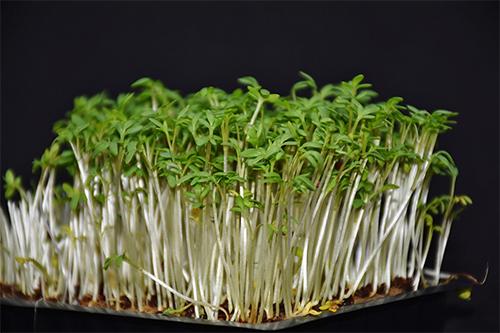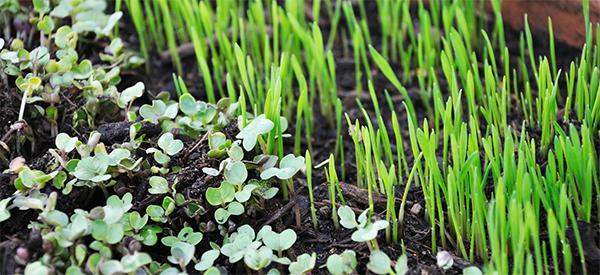You’ll probably have spotted microgreens for sale in your local health food store or in the salad section at the supermarket. Microgreens are bang on trend, and tend to come with a high price tag! The good news is that they are incredibly simple to grow, and there are many good reasons to try your hand at producing this delicious and valuable crop.
Related: How I Grow My Herbs Indoors
What are microgreens?
Microgreens are simply the very young seedlings of vegetables, herbs or edible flowers. Unlike sprouts, microgreens are harvested after the young plant stems have reached a length of one to three inches, and when the first seed leaves (called cotyledons) have formed. Any entirely edible plant can be grown as a microgreen, but certain varieties are popular because they have a good flavor and color. Here are some of the most well-liked types of microgreen:
- Beets
- Chard
- Radish
- Mustard
- Kale
- Arugula
- Cress
- Brocoli
- Sunflower
- Watercress

An enjoyable option for the beginner microgreens gardener is to buy a packed of mixed salad seeds or a microgreen seed mix, either of which will provide you with an interesting first harvest of varying tastes and textures. As you become more comfortable with the process of growing microgreens, you can experiment with a wider range of seeds that will give you a more unusual spectrum of flavors to enjoy.
Related: How I Grow My Food In A Basement
What are the benefits of growing microgreens?
- Microgreens offer a year-round source of food. Microgreens can be grown at any time of year, giving you a source of fresh greenery even in the depths of winter.
- Microgreens provide a very fast crop. Microgreens have a fast turnaround, being ready to harvest between seven and twenty one days after sowing.
- Micrgreens are nutritionally dense. Microgreens pack all of the vitamins and minerals and polyphenols of a fully grown plant into a much smaller package, giving you many of the nutrients you need with just a modest handful of food.
- Microgreens can be grown easily and with simple equipment. You don’t even need a garden to grow microgreens! At most times of year, microgreens can be grown on a sunny windowsill. They require limited equipment and minimal maintenance. As they are harvested young, they are rarely troubled by diseases of pests.
Equipment needed for growing microgreens indoor:
- Seeds: opt for one of the more popular microgreen seed types initially.
- Shallow tray: a leftover plastic take-out container is a free and easily available option.
- Potting soil: seeds will germinate best in a fine soil. Go organic if you can afford it!
- Spray bottle/mister: essential for gentle watering of your delicate seedlings.
- South-facing window sill or similar: choose a spot where your seedlings will get adequate sunlight.
Optional extras
- Tray lid or plastic wrap: some seeds germinate better with a lid or covering. This maintains a higher and more consistent level of humidity when compared to a tray that is left open.
- Grow lights: these need not be expensive, but they will allow you to grow microgreens more consistently during the winter when light levels are lower. A grow light can easily be mounted under a kitchen cabinet so your seedling trays can sit on the counter throughout the year.
- Seedling heating mat: this speeds up the germination process, particularly when temperatures drop.
Related: Top 10 Foods to Grow for Survival
How to grow microgreens indoors:
- Firstly ensure that your tray is clean. If it doesn’t have any drainage holes, begin by poking some holes in the base.
- Spread around an inch of potting soil in the tray, smoothing it out so that is has an even surface. Take care not to compress the soil too much. If the soil is completely dry, spray it with a mister to moisten it.
- Scatter your seed mix evenly onto the soil, making sure that you are not overcrowding them. However, you will be harvesting them young so they do not need as much space as when being grown to full size.
- Cover the seeds with a fine layer of soil. A general rule of thumb is that the finer the seed, the thinner the layer of soil is required to cover them.
- Mist the soil gently but thoroughly. If you have a warm and sunny windowsill, place your tray here ensuring that it will receive a minimum of 4 hours sunlight per day. Alternatively, place them under your grow lights.
- If your tray has a lid, put it on. Plastic wrap can be used as an alternative covering. Many microgreen seedlings will germinate without a covering, so test this out for yourself and see what works best in your home.
- Once your seedlings have sprouted, remove the lid or covering. Continue to mist the soil once or twice a day according to the temperature in your home. Regularly check the soil to ensure it hasn’t dried out.
Some seeds germinate better with an overnight soaking in water. You can refer to the seed packet or simply experiment with this for yourself.
Harvesting your microgreens
Your microgreens are harvested by cutting above soil level using scissors or a well-sharpened knife. Some microgreen growers choose to harvest their crop as soon as the first pair of leaves (the cotyledons) have formed. Others allow the next pair of true leaves to appear before they harvest. There is no hard and fast rule, and it is worth tasting your microgreens at different phases to find the flavor and texture that you enjoy most.
Wash your microgreens carefully before eating.
You may also like:
Eat This Herb Every Morning for an Eagle Eye Vision at 80
10 Things Cowboys Carried With Them in the Wild West to Survive (Video)
Eat This Herb Every Morning for an Eagle Eye Vision at 80
Similar to Morphine: The Best Natural Painkiller that Grows in Your Backyard
















I grow microgreens and my family and friends are enjoying them mightily. We grow sunflowers, peas, lettuce and a mix of kale and other cabbage-like plants. They have made a difference in my health. Being over 60, certain male function was not working like when I was young. I believe it is decreasing of inflammation in general in my body due to eating a big salad with microgreens once a day and trying to eat a healthy balance at other times in the day. I recommend it to everyone.
This seems to be a ridiculously easy way for even urban preppers to augment their diet. The only caveat I can think of is that you have to keep buying seeds… perhaps looking for seeds at the end of season is one solution. Buying mixed birdseed is another option, as most contain sunflower seeds, millet and other sproutable seed. I’m planning on experimenting with micro greens, so I’ll post on how I’m doing.
Maybe AAP can post a related article on the most nutritious types of sprouts?
Where can I buy micro green seeds
There are a lot of places that sell seeds specifically for sprouting if you do a search online, and there are many sprouts you can grow from either commonly available whole grains and legumes you can buy at the grocery store. Check with your favorite seed supplier…chances are they will have not only seeds, but entire kits to get you started.
Birdseed mix if untreated has sunflower, millet, and other grains that have edible sprouts. Mung beans for sprouting can be found at some supermarkets and ethnic markets. Dollar stores often sell condiment seeds like fennel, mustard and dill in the spice aisle…if they don’t sprout you can still use them for cooking.
YouTube also has videos available on the subject…some of them are very good.
Miz Kitty: Hi! No, not anything to say, just wanted to say hey 🙂 that’s a seriously good idea. And, sunflower seeds in bird seed are a lot higher in oil and so on. You can eat any bean sprout. We soak ours, changing the water a lot, for about 3 days. when they sprout, they’re cooked and cook fast. We rinse them because the skins can contain a little risin. Most get frozen till needed and they freeze well. Peas, lentils, and so on from the store are good for sprouting. Most condiment seeds are coming in from out of the nation and have to be irradiated, which kills them. niio
Back at ya, Red!?
Good point about the irradiation…but still worth a shot for a buck or so. Had a bad tooth a while back…turned out a sesame seed had lodged in a cavity and SPROUTED! No lie…I was shocked more because it had been baked, frozen and toasted and was still viable than because it was growing in my mouth. Can’t say the same for the dentist…they said they’d never seen the like.
I have some sesame seeds I might try out, too.
I was going to get started this afternoon, but we lost the power and I was puttering around getting my “power outage” preps set up. We were lucky – it was only out for about five hours.
Miz Kitty: Hey-lo angel! Of course good. Am I not the finest mine of general misinformation and useless trivia you ever met? 🙂 Sesame is a commercial crop across most of the American dry lands and northern Mexico. We still import it by the ton, but that percentage is getting lower. Irradiation in American-produced spices is to kill insect eggs. Buy local and use bay leaves for short-term storage. Things like mustard used to be common crops in the Northeast.
An aunt and cousins down towards Philly asked me how to get millers out of a loaf of store-bought bread. Huh? Throw it out for the chickens, it’s stale. They said no, it was fresh and showed me the date. No, it has to be stale because it takes a week just for the eggs to hatch, and longer to go from worm to miller. Commercial bakeries are taking returned bread and repackaging it. Up where I lived, people threatened lawsuits on stores, and now the stores check each delivery.
No, do not put a sesame seed in the tooth! 🙂 I tried to use what I have, but it came in from Mexico. Still, it’s a cool plant, loves the heat and dryness, and doesn’t have a lot of insect problems. If you can sprout some, it wants full sun and very little water or it can get root rot.
Last time we lost power, there was a convoy of very angry people that went to the office to scream at workers. If it ain’t got thorns, horns, or fangs, it’s poison–that’s Arizona 🙂 And the dog claims a national security issue is at hand. He’s walking around with his hind legs crossed and his eyes are turnin’ yellow. niio
Where is the best place to buy organic seeds?
You have a computer, go on line and do a quick search. I am sure you will come up with a variety of names. Read the reviews that people have written about the company.
There is always our old friendly neighborhood merchant Amazon.
The preppier who is going to survive must be quick on his feet and able to adapt to changing situations. Some topics it is well to solicit advice from others on the list, and simple things like where to buy something in bygone eras such a search would require a trip to the library to search through phone books. Those days are long gone. If used for nothing else, the internet is a tremendous reference resource. Use it. I can’t count the number of times a week I look up what the internet has to say about a topic. Even Wikipedia, although many people like to castigate it, makes a good reference tool.
Look them up on YouTube you will be amazed. I know it can be a wasteland but sometimes you can find gems in there.
Buying seeds in the little garden packs would be expensive. Which plant seeds that I can buy by the bushel from a farmer would make good microgreens? I have access to wheat, corn, soybeans, millet, alfalfa.
There are several good sources of seeds. You can do a search and find those places. The first time we went to our local nursery and paid $25 for an ounce of lettuce seed. I have mostly used True Leaf Market since then. They will charge $4-5 for an ounce and the cost goes way down if you buy 4 ounces or a pound. Peas and sunflowers are cheaper still. Let me know if you need help figuring out their system
There is a USDA and Univ of Maryland study from many years ago that published their research saying that microgreens were 4-40 times more nutritious as compared to the same plants as adults. You can find the study on the internet. If you can’t find it, let me know and I will find it and e-mail it to you.
I wonder how microgreens compare to just sprouted seeds in nutrition value. Sprouting seeds would be still quicker and easier. Sprouting only requires wet clothes.
spike: (In case you didn’t know and for those who don’t) Aflatoxins and other things live on seed surfaces. when they get moisture and some heat, they thrive. One gallon warm water, a couple of caps of bleach, soak the seeds for a few hours and then rinse well, twice, soaking them for a few hours in warm water, and sprout. If we have to do this for livestock sprouts, it goes double for humans. Modern brewers don’t bother because they add chemicals that kill off the spores. I learned from people who taught me the old way to sprout,niio
Red, Good point. Something to investigate but I’ve seen vegetable sprouts in salad bars for many years. Do they disinfect the seeds before they sprout them? And what effect does this bleach have on germination?
By law, yes. companies that sprout have to disinfect. Early on, there were cases of food poisoning caused by them. they tried to blame customers, then kitchen help, but wound up losing when the FDA came in and took tests. Like I said,, if we have to for livestock, then it goes double for us. Some recommend bleach, others peroxide and so on. Stay safe, we need you. 🙂
https://www.fda.gov/media/102430/download
https://mtgarfieldgreenhouse.wordpress.com/tag/disinfecting-seeds-for-sprouting/
True Leaf Market and Johnnie’s Seeds both have organic seeds. I’m sure there are more places that sell organic seeds in quantity for microgreens. Look around on the internet.
Thank you, Doc, good post!
Anything in the cabbage family needs light to sprout. I like chia because it’ll sprout in a few hours. Give it a day and it’s getting long. One major problem, most chia is imported and irradiated to kill it. If you grow your own seed, it likes it on the dry side and can get 3 feet tall and about that bushy. It likes approximately 12 hours of sun. too much more, no blooms, same with much less. Mountain/Tarahumara chia is smaller and so are the seeds (these are also used on chia pets), but have the same benefits as the overpriced seeds in the store. A plus, mountain chia isn’t daylight sensitive. niio